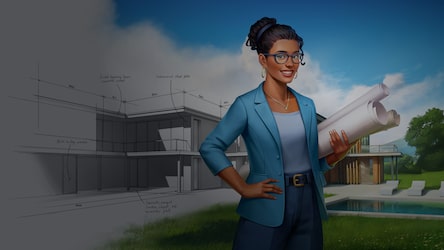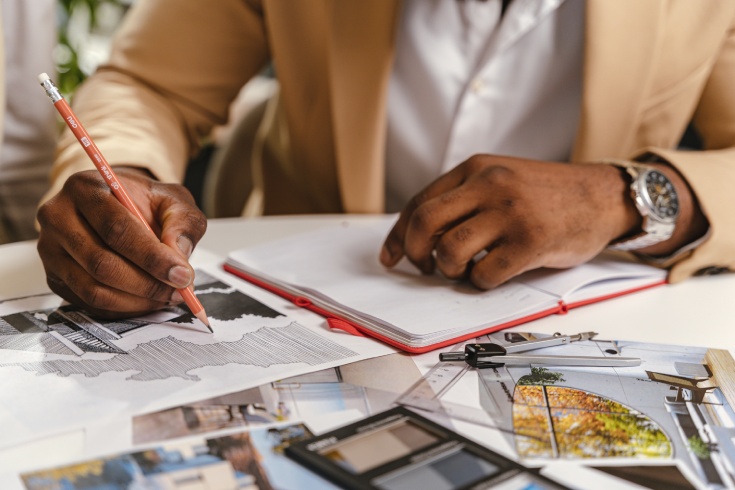Architect Insights on Combining Form and Function
The Function of Sustainability and Modern Technology in Modern Architect Practices
Sustainability and innovation are reshaping modern design in methods you could not expect. By welcoming green materials and clever technologies, engineers are not just creating buildings; they're crafting atmospheres that enhance our top quality of life.
The Value of Lasting Style
Sustainable style is important not simply for the setting yet likewise for enhancing our quality of life. When you accept sustainable style, you're not just minimizing your carbon impact; you're producing rooms that advertise wellness and wellness.
Additionally, lasting architecture commonly causes more powerful communities. When structures are developed with eco-friendly techniques, they can inspire others to follow suit, promoting a society of sustainability. You'll notice boosted property values and a greater feeling of satisfaction in your surroundings.
Finally, by focusing on sustainability, you're buying the future. You're guaranteeing that future generations enjoy a much healthier planet and vivid communities. So, when you consider your next task, consider exactly how sustainable style can elevate your life and those around you.
Innovative Materials Changing Building Practices
As you check out cutting-edge materials in architecture, you'll locate that eco-friendly building and construction products are reshaping just how we believe about sustainability. Recycled web content developments are giving new life to waste, while clever product technologies enhance building efficiency. These advancements not only promote eco-friendliness but likewise push the borders of design.
Naturally Degradable Building Materials
While traditional construction products commonly add to ecological destruction, naturally degradable building products are emerging as a practical choice that changes structure techniques. You can explore choices like hempcrete, mycelium, and bamboo, which not only lower waste yet likewise promote sustainability. These materials break down naturally at the end of their lifecycle, lessening landfill contributions. By incorporating naturally degradable options right into your layouts, you're not simply improving aesthetic allure; you're likewise making a positive effect on the earth. And also, they usually call for much less power to generate, further lowering your project's carbon footprint. As you adapt to these innovative products, you'll find that they use resilience and adaptability, enabling you to develop frameworks that align with modern-day worths of sustainability and obligation.
Recycled Content Technologies
Recently, ingenious products with high recycled material have changed structure practices, supplying designers interesting new alternatives - Architect. You can now incorporate materials like recycled steel, which not only decreases waste however also boasts remarkable stamina. Recycled glass is one more amazing choice, offering visual charm while reducing environmental influence

Smart Material Technologies
Smart product modern technologies are reshaping the means you believe regarding constructing methods, offering dynamic solutions that adjust to changing problems. These cutting-edge products, such as self-healing concrete and thermochromic glass, boost structure performance and sustainability. By integrating smart materials, you can create energy-efficient designs that react to their environment, lowering general power consumption.
The Combination of Smart Technologies in Style
As modern technology progresses, incorporating wise services right into architectural design ends up being crucial for developing sustainable and reliable areas. You can integrate smart technologies like building management systems, which enhance power use and boost passenger convenience. Sensors can keep track of ecological conditions, changing lighting and temperature instantly based upon real-time data. This versatility not just enhances customer experience but likewise minimizes energy intake.
Including Internet of Points (IoT) devices permits smooth interaction amongst numerous structure systems, allowing you to make data-driven decisions that boost capability. Smart materials that react to environmental changes can better boost your design, providing dynamic options to ever-changing problems.
Energy Effectiveness and Renewable Resource Solutions
While several engineers focus on aesthetics, prioritizing energy performance and renewable resource services is important for sustainable design. You can begin by incorporating passive solar layout, which maximizes all-natural light and heat, minimizing reliance on man-made illumination and heating unit. Make use of high-performance insulation and energy-efficient windows to reduce power loss.
Do not forget eco-friendly power systems-- mount solar panels or wind turbines to produce tidy power on-site. You can also consider integrating geothermal heating and cooling systems for an extra lasting temperature level law.
By choosing energy-efficient devices and lights, you'll not only decrease energy consumption however likewise lower operational costs for building passengers.
Including these concepts into your styles not just benefits the environment but likewise improves the building's allure and worth. Ultimately, your dedication to power performance and renewable resource will establish your projects apart in an open market.
Water Preservation Methods in Modern Design
Including water preservation strategies right into modern-day style is crucial for creating sustainable buildings that lessen environmental effect. You can achieve this by incorporating rain harvesting systems, which accumulate and store rainfall for irrigation and non-potable usages. Carrying out low-flow components and smart watering systems also minimizes water consumption, making certain efficient use throughout the structure.
Think about using drought-resistant landscape design, which needs much less water and advertises biodiversity. Including absorptive paving materials permits rainwater to penetrate the ground, minimizing overflow and reenergizing groundwater supplies.
Additionally, installing greywater recycling systems can repurpose water from sinks and showers for commode flushing or watering, additional preserving resources.
The Impact of Biophilic Layout on Health
Biophilic design brings nature inside your home, and you'll discover its favorable results on your health and wellness and happiness. By improving indoor air high quality and attaching you with all-natural components, these areas can transform your day-to-day experience. Let's discover exactly how integrating these features can boost your total wellness.
Nature's Impact on Health and wellness
How does our setting form our health? When you integrate components of nature into your surroundings, it can substantially enhance your physical and psychological health and wellness. Biophilic style, which stresses all-natural light, plants, and organic materials, promotes a this page feeling of connection to the outdoors. This link can minimize tension, boost state of mind, and boost cognitive function. You might discover that spaces loaded with greenery urge creativity and productivity, making your everyday jobs feel extra pleasurable. Furthermore, all-natural components can help you feel extra relaxed and focused, promoting overall well-being. By focusing on nature in your environment, you're not just enhancing your room; you're likewise supporting your health and happiness. Accepting biophilic design is an action toward a healthier way of living.
Enhancing Indoor Air Quality
While lots of people concentrate on looks and capability in design, enhancing indoor air quality plays a necessary duty in your overall well-being. By incorporating biophilic style aspects, you can boost air high quality naturally. Focusing on these facets in your layout will certainly not just elevate your area however also advertise a feeling of tranquility and wellness.
Link With Natural Aspects
When you attach with natural environments in your room, you not only enhance its aesthetic allure however additionally significantly enhance your well-being. Biophilic layout urges you to integrate attributes like plants, all-natural light, and organic materials. These elements create a calming ambience, reducing stress and anxiousness. Research study reveals that click here now being around nature can boost your mood and cognitive feature, helping you really feel extra concentrated and productive. When you welcome the outdoors inside, you could observe much better air high quality and increased comfort. Straightforward changes, like adding a living wall surface or big windows, can exceptionally affect your experience (Architect). Eventually, integrating nature into your atmosphere leads you to a healthier, better way of life, promoting a deeper link to the globe around you.
Future Trends in Sustainable Architectural Practices
As the globe encounters pushing environmental challenges, designers are significantly embracing ingenious techniques to sustainability that redefine how we layout and develop. You'll see a surge in biophilic layout, integrating nature into metropolitan spaces to boost wellness and reduce energy consumption. Smart innovations, like AI and IoT, are improving energy administration in structures, optimizing source use, and lessening waste.
In addition, modular building and construction is obtaining grip, enabling faster, more efficient building procedures while decreasing ecological impact. Using sustainable products, such as reclaimed timber and recycled steels, is ending up being basic technique. As you discover these trends, anticipate a shift towards circular design, emphasizing the lifecycle of materials and advertising reuse and recycling.
These forward-thinking approaches not only address environmental worries yet likewise create much healthier, much more durable areas. By remaining educated concerning these trends, you can assist form a lasting future in design.
Frequently Asked Inquiries
How Can Sustainability Affect Job Budgets and expenses?
Sustainability can substantially influence job expenses and budgets. You could discover that initial investments in environment-friendly products or technologies result in long-term savings via power performance, decreased waste, and potential federal government rewards, inevitably balancing the overall costs.
What Qualifications Exist for Lasting Style?
You'll locate numerous qualifications for sustainable design, including LEED, BREEAM, and the Read Full Report Living Structure Difficulty. These qualifications aid you demonstrate your dedication to sustainability and can improve your project's integrity and attract customers.
How Does Local Society Impact Sustainable Design?
Regional culture shapes sustainable style by showing area worths, traditions, and materials. You'll discover that integrating local appearances and techniques not just respects heritage however likewise improves the performance and approval of your building tasks.
What Role Does Customer Education And Learning Play in Lasting Practices?
Client education's crucial for promoting sustainable techniques. When you notify clients regarding advantages, costs, and environmental effects, you empower them to make enlightened decisions, cultivating a collaborative technique that enhances the task's general sustainability.

Exactly How Can Architects Determine the Success of Sustainability Campaigns?
You can measure the success of sustainability efforts by tracking energy intake, reviewing product effectiveness, and gathering comments from clients. Routine audits and comparisons versus benchmarks will help you fine-tune your methods and display improvements properly.
By incorporating smart materials, you can create energy-efficient styles that respond to their setting, decreasing overall energy usage.While many architects focus on looks, prioritizing power effectiveness and eco-friendly power remedies is crucial for sustainable layout. Biophilic design, which stresses natural light, plants, and organic materials, fosters a feeling of link to the outdoors. Biophilic style encourages you to integrate functions like plants, all-natural light, and natural materials. As you explore these patterns, expect a shift toward circular design, stressing the lifecycle of materials and promoting reuse and recycling.